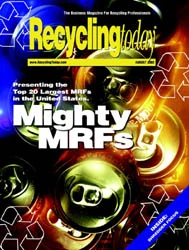The trend toward more single-stream recycling programs has generated a tremendous amount of interest. Advocates of the sorting and processing procedure note the ability to collect larger amounts of material most cost effectively.
However, opponents feel that as recyclables are commingled together the quality of the collected material significantly declines, resulting in increased residue and lower value of the material.
During the Paper Recycling Conference & Exposition, held in June in New Orleans, three speakers weighed in on the positives and negatives to this method. Speakers at the panel included a representative from a waste management firm, a representative from a Canadian-based paper company, and a consultant to the solid waste and recycling industry.
Brian Taylor, editor of Recycling Today magazine, noted that over the past decade, “most communities remained committed to curbside recycling, but public officials also scrutinized the cost of operations much more carefully. On the collections end, cost savings were sought by putting fewer trucks with fewer people on the road, with these trucks ideally running faster routes while collecting more material.”
To deal with the material in a cost-effective manner, Taylor continued, “Advocates (of single stream methods) see single-stream processing and mechanical sorting advances as the hope toward the maximum recovery of recyclables. The short-term pain may be blurred paper grades and some rejected shipments, but ultimately MRFs are being equipped to reliably handle a greater percentage of the solid waste stream while shipping out a number of marketable secondary commodities.”
Harvey Gershman, president of the consulting firm GBB Inc., Fairfax, Va., ticked off some of the biggest disadvantages to single stream.
One is the residue in the paper, especially glass. “Glass in the single stream is a problem.
Additionally, said Gershman, “There are higher processing costs. It costs more to unscramble a more scrambled egg. There are more sorting costs. In a dual stream system glass is more easily sorted. That doesn’t happen in a single stream flow.”
While glass can be a problem, Gershman noted that the amount of glass in the recyclables stream is declining. According to Gershman, glass right now constitutes only around 5 percent of the average collected stream. With this in mind, he adds that it may be a better move to remove glass from the materials collected.
Concerning the growth of single stream MRFs, Gershman noted that there was one of these types of MRFs less than 15 years ago. Now, there are around 85 single-stream MRFs, with more expected to be added over the next several years.
Rina McGuire, with Cascades, a large Canadian-based forest products company, said that the company “didn’t care” whether the material came from a single or multi-stream source.
While the company didn’t come out strongly on either side, she did stress that the quality of the material was essential. Additionally, anyone looking to ship to the company’s mills also needs an ample quantity of material.
One of the biggest downsides to single-stream programs can be the low quality of the processed material. “If you need more manual sorting it is very costly. There is a higher level of contamination.”
To achieve higher quality, McGuire stressed that the ideal situation is to take in material from a same group of suppliers. At the same time, the need for price stability is a major issue for the material.
Steve Ragiel, vice president of recycling for Waste Management Inc., Houston, said some of the issues with current recycling programs include high collection costs, high processing costs, extremely volatile commodity pricing, and the capital intensive nature of programs while extremely tight municipal budgets.
The primary advantages for single stream collection is the lower collection cost and an adequate supply of material for mills, Ragiel noted.
He added that while many opponents of single stream processing cite glass contamination as a big problem, he feels that with the proper sorting, there are some viable end markets for the material. A key type of equipment to use is an optical sorting system to extract glass, he added.
Backing this opinion, Ragiel said that Waste Management already has more than a dozen single stream recycling facilities, with a number of other facilities scheduled to be re-opened by the end of the year.

Explore the August 2002 Issue
Check out more from this issue and find your next story to read.
Latest from Recycling Today
- Athens Services terminates contract with San Marino, California
- Partners develop specialty response vehicles for LIB fires
- Sonoco cites OCC shortage for price hike in Europe
- British Steel mill’s future up in the air
- Tomra applies GAINnext AI technology to upgrade wrought aluminum scrap
- Redwood Materials partners with Isuzu Commercial Truck
- The push for more supply
- ReMA PSI Chapter adds 7 members





